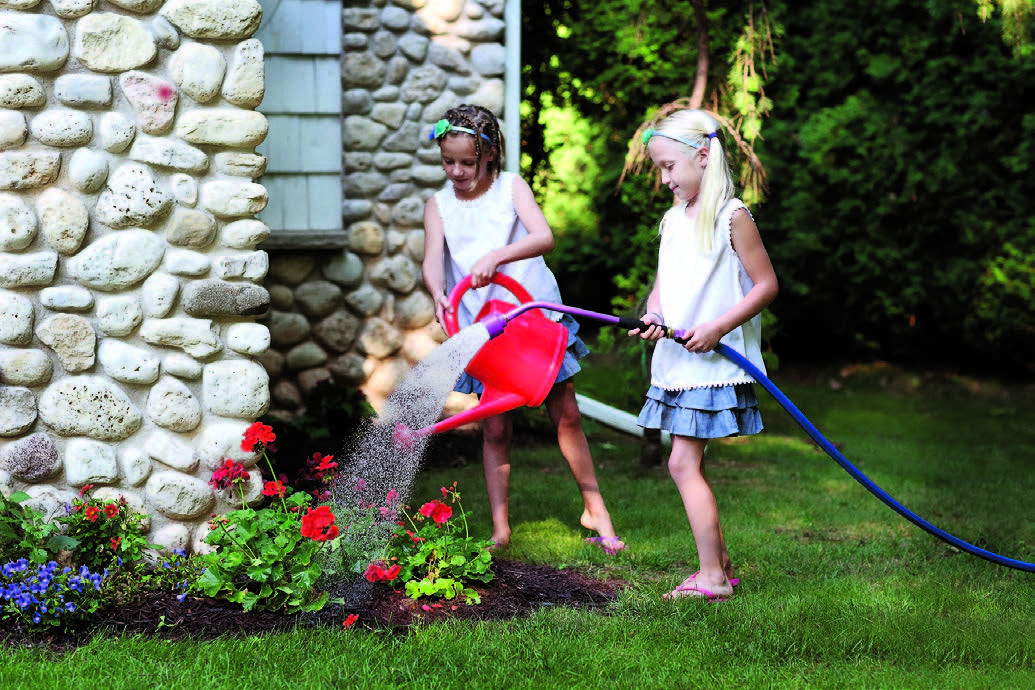Water-Wise Tips for Happy Plants
HOW YOU WATER IS AS IMPORTANT AS HOW MUCH YOU WATER
It’s summertime and for many it provides the enjoyment of tending to a garden but with it comes challenges on the way to a bountiful harvest.
“Working for Dramm Corp., a watering tool company, I have often been asked, ‘How important is it to water plants?’” said Jessica Rein- hardt. “Watering is extremely important! The reason is that nutrients found naturally in the soil, or even added supplements, are valueless unless they are first dissolved in water. Plants can only assimilate nutri- ents through their roots as the nutrients dilute.”
But Reinhardt stresses that even more important than watering plants is learning to water wisely.
“Watering wisely will produce optimum growing for any plants and/ or vegetables while saving time and money as well as reducing the strain on the environment,” she said. “When watering plants, it is best to mimic nature and simulate a natural rainfall for deep-root watering. Since 90 to 98 percent of plant matter is water, the most essential task to ensure healthy plants is to provide sufficient amounts of water. Wa- ter applied in small quantities is more harmful than helpful, as only the very top layer of soil is moistened, which causes the plant roots to grow to the surface. This subjects the plant to rapid drying and damage.”
Reinhardt contends that large quantities of water should be applied in a single application in order to moisten the soil.
“For flowerbeds and vegetable gardens, one inch of water is recom- mended, but be sure to read your plant tag for more precise informa- tion on your specific plant,” she said.
Trying to mimic nature is exactly what John Dramm had in mind 76 years ago when he invented the 400 Water Breaker Nozzle to more efficiently water the plants in his Manitowoc flower shop without dam- aging them. Today, Dramm’s Rain Wand is widely used commercially and residentially.
“I recommend using a Rain Wand or a watering can,” said Reinhardt. “Either of these tools will greatly minimize water loss from run-off and evaporation.”
Reinhardt said you want to aim your hand-watering tool near the soil, allowing the water to go directly to the soil, rather then onto the plant, reducing evaporation on leaf surfaces.
“Also, applying water at the base of the plant keeps foliage dry to help prevent fungus diseases, such as botrytis and mildew,” she added. Water in the early morning, preferably before sunrise, or in the evening after sunset to reduce water lose to evaporation.
And, in the case of drought, use gray water such as bath water or dishwater to water your plants.
An alternative to hand watering, according to Reinhardt, is to put a soaker hose around the garden.
“A soaker hose will ease the burden of watering while still providing sufficient amounts of water that the garden needs. This type of hose is designed to evenly distribute tiny water droplets directly into the root zone of the plant, which reduces water loss due to evaporation,” she instructs. “For best results, set the hose around the base of the plants and hook it up to a water timer. For the most accurate results, time how long it takes to fully water your garden, and in the future you simply need to set your water timer to that time and you’re done.”
Reinhardt stresses the importance of purchasing thick, good quality soaker hoses.
“Some soaker hoses have thin walls, which can create “geyser” ef- fects and therefore do not evenly water from the beginning to the end of the hose,” she said.
Dramm, which remains family-owned and operated, provides more tips online at www.dramm.com, or join Dramm on Facebook.




